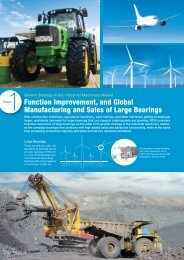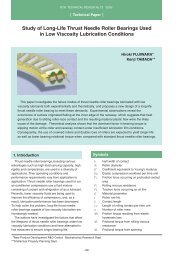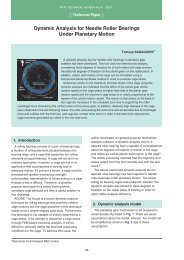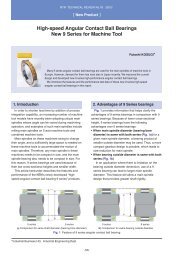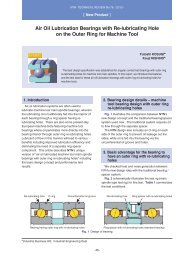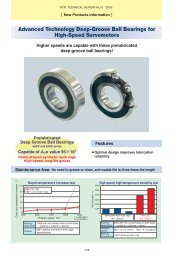Special Issue; Products for Industrial Machinery - NTN
Special Issue; Products for Industrial Machinery - NTN
Special Issue; Products for Industrial Machinery - NTN
You also want an ePaper? Increase the reach of your titles
YUMPU automatically turns print PDFs into web optimized ePapers that Google loves.
Atmospheric Control Method <strong>for</strong> JIS-SUJ2 Carbonitriding Processes<br />
4. Nitrogen Penetration Mechanism,<br />
and Prediction of Nitrogen<br />
Concentration Distribution<br />
From these findings, it is apparent that regarding<br />
nitrogen penetration during carbonitriding of JIS-SUJ2<br />
high-carbon chromium bearing steel, the following<br />
three factors are critical: 1) partial pressure of<br />
undecomposed NH3 in the furnace, 2) ac* in the<br />
atmosphere (carbon activity), and 3) H2 partial<br />
pressure in the furnace. Based on these findings, the<br />
nitrogen penetration mechanism and the method <strong>for</strong><br />
predicting nitrogen concentration are discussed<br />
below.<br />
4.1 Hypothesis of the nitrogen penetration<br />
mechanism<br />
Let us assume that the nitrogen penetration in<br />
carbonitriding of JIS-SUJ2 proceeds according to the<br />
equilibrium reaction defined in expression (5).<br />
Expression (6) represents the equilibrium constant KX<br />
<strong>for</strong> expression (5).<br />
N3/2H2NH3<br />
P NH3<br />
a N <br />
K X P H2<br />
3<br />
2<br />
5<br />
6<br />
where, aN* is “an unknown quantity equivalent to<br />
the nitrogen activity” in equilibrium between<br />
atmospheric gas and steel, and the unit of partial<br />
pressure is atm. For convenience, the equilibrium<br />
constant K X in expression (6) is allowed to remain an<br />
unknown quantity.<br />
In a carbonitriding process, even if the carbon<br />
potential, carburizing duration and process<br />
temperature remain unchanged, the carburized depth<br />
can vary depending on variation in the atmospheric<br />
components according to Neumann et al. 7) They<br />
expressed the cause of this phenomenon with a<br />
carbon penetration velocity <strong>for</strong>mula (expression (7))<br />
that uses a carbon transfer coefficient .<br />
qC G C s 7<br />
where, q = carbon penetration velocity (g/mm 2 s); <br />
= carbon transfer coefficient (g/mm 2 s); C G = final<br />
carbon concentration (wt%); C S =carbon concentration<br />
on the material’s outermost surface (wt%).<br />
Being equivalent to the carbon potential, C G can be<br />
expressed as a product of the carbon activity ac and a<br />
carbon solubility limit concentration A S . There<strong>for</strong>e,<br />
expression (7) can be rewritten as expression (7’)<br />
below.<br />
qacAsCs7’<br />
If the manner of the nitrogen penetration<br />
mechanism is assumed to be identical to that of the<br />
carbon penetration mechanism, then, by referring to<br />
expression (7), the nitrogen penetration velocity can<br />
be described by expression (8) below.<br />
q N N N G N s 8<br />
where, q N = nitrogen penetration velocity (g/mm 2 s);<br />
N = nitrogen transfer coefficient (g/mm 2 s); N G = final<br />
nitrogen concentration (wt%); N S = nitrogen<br />
concentration on the material’s outermost surface<br />
(wt%).<br />
Then, expression (8) is rewritten as expression (8’)<br />
below by replacing N G in expression (8) with a N -A SN .<br />
q N N a N A SN N s 8'<br />
where, A SN is the saturation value of nitrogen<br />
concentration (wt%).<br />
When expression (6) is substituted in expression<br />
(8’), then the nitrogen penetration velocity is defined<br />
by expression (9).<br />
P<br />
<br />
NH3<br />
3<br />
K X P H2<br />
2<br />
q N N A SN N s<br />
9<br />
In expression (9), the variables that can be<br />
investigated by measuring the atmosphere <strong>for</strong><br />
carbonitriding processes are NH3 partial pressure and<br />
H2 partial pressure. Since NS is determined based on<br />
the actual measurements of nitrogen concentration<br />
distribution, there are three unknown quantities in<br />
expression (9): N , K X , and A SN . ( N S can also be<br />
determined through calculation involving N , K X , A SN<br />
and the diffusion coefficient D.)<br />
4.2 Hypothesis about nitrogen concentration<br />
distribution in steel<br />
Suppose that the nitrogen concentration distribution<br />
profile is compatible with the Gaussian error function<br />
as in the case of the carbon concentration profile, then<br />
the nitrogen concentration distribution profile can be<br />
expressed by the expression (10).<br />
X<br />
<br />
<br />
NN s 1erf<br />
2Dt t<br />
10<br />
where, N = nitrogen concentration at a position X<br />
(wt%); N S = nitrogen concentration on the material’s<br />
outermost surface (wt%); X = distance from the<br />
surface of the material being processed (mm); D =<br />
diffusion coefficient (mm 2 /s); and t t = process duration<br />
(s). The unknown quantity in expression (10) is the<br />
diffusion coefficient D because the diffusion coefficient<br />
is dependent on nitrogen concentration. Next, let us<br />
assume that the diffusion coefficient is approximated<br />
-49-




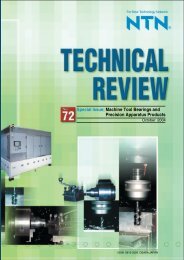
![[New Product] Unit Products for Office Equipment - NTN](https://img.yumpu.com/27154451/1/184x260/new-product-unit-products-for-office-equipment-ntn.jpg?quality=85)
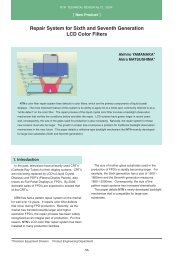
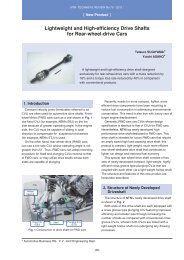
![[New Product] Development of Oil-impregnated Sintered ... - NTN](https://img.yumpu.com/27154427/1/184x260/new-product-development-of-oil-impregnated-sintered-ntn.jpg?quality=85)

